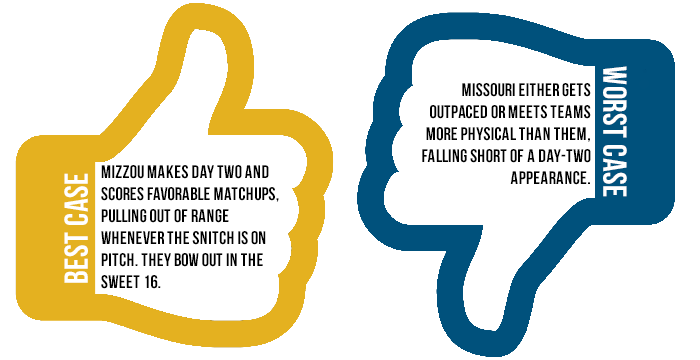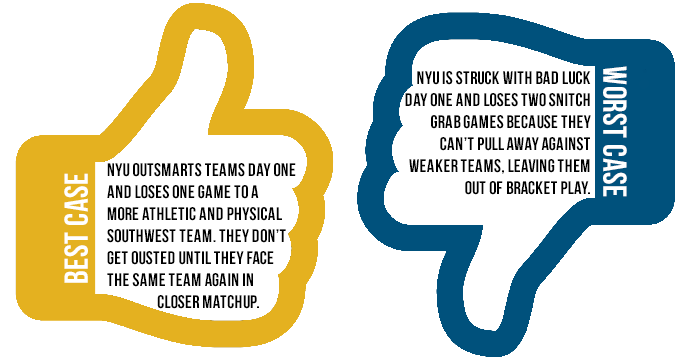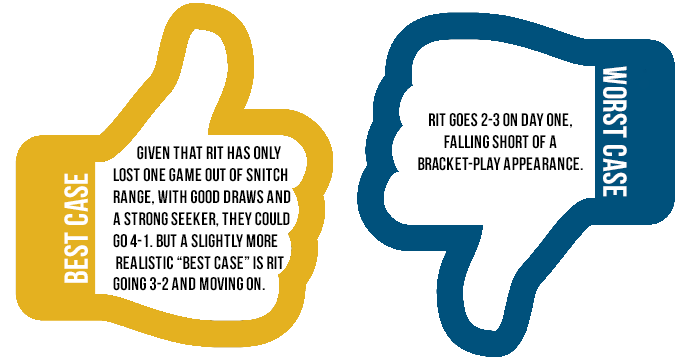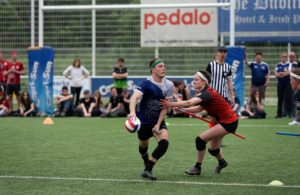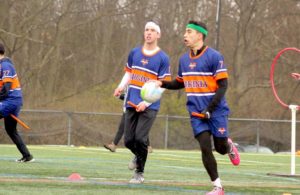- Rule, Britannia, no more?
- Unpopular Opinions: US Quadball Cup 2023
- Proven Contenders: University of Virginia
- Proven Contenders: Rutgers University
- Proven Contenders: University of Michigan
- Proven Contenders: Creighton University
- Different Perspectives: A Look Inside USA Ultimate
- Antwerp QC, Much of Belgian Core, Leaves Competitive Quidditch
Part II
Rock Hill Roll Call is your in-depth guide to the 80 teams that will compete for the title of World Cup 8 Champion. We’ve reached out to writers and analysts all over the country to bring you the lineups, strategies, focal points and aspirations of each and every attending team. Whether you are looking for a leg up on the competition or just want a detailed preview of the sport’s main event, this is the place for you.
 By Anonymous
By Anonymous
University of Missouri is a two-headed monster due to their speed and their physical play. Every player on Mizzou is fast, and every player on Mizzou receives and delivers hits often. This creates an offense that is very difficult to stop and a defense that can be frustrating.
Their best quaffle player is keeper Josh Ebbesmeyer. Defensively, he uses his 6’4” structure to stop the majority of shots thrown his way. On offense, Ebbesmeyer is a great distributor with an excellent mid- and long-range shot. Adding to his arsenal, Ebbesmeyer also possesses the quick feet create a separation from the opposing point defender.
Their beater corps last semester was anchored 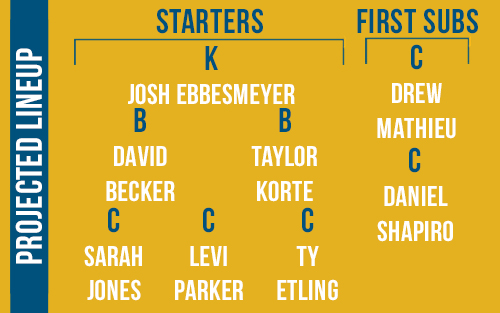 by Taylor Korte, Brett Smith and freshman David Becker. However, Smith will be noticeably absent this spring. Planning for the inevitable, Mizzou has been starting Becker over Smith most of the fall to prepare for Smith dispatching for boot camp, and it looks like the freshman has adapted well to the portion of time he has been given. But will Becker truly be capable of filling Smith’s shoes and thriving without the veteran’s guidance?
by Taylor Korte, Brett Smith and freshman David Becker. However, Smith will be noticeably absent this spring. Planning for the inevitable, Mizzou has been starting Becker over Smith most of the fall to prepare for Smith dispatching for boot camp, and it looks like the freshman has adapted well to the portion of time he has been given. But will Becker truly be capable of filling Smith’s shoes and thriving without the veteran’s guidance?
Mizzou is a chameleon of sorts, they are constantly evolving their play to effectively counteract opposition. They play University of Arkansas frequently, which has shaped their style of play into “bump-and-run.” They have also picked up on the 1.5 strategy from their interactions with University of Kansas.
So what’s the key to beating Mizzou? Inconsistency. Avoid patterns. The more options on offense and the more flexible a defensive scheme, the better shot you have at coming away with the win.
 By Nick Sorrentino
By Nick Sorrentino
Smith has been a rock on Mizzou’s team, leading their beating corps and the team as a whole. He is that player that makes the effort to go out and gain experience whenever and wherever possible. If he wasn’t departing for the armed forces this spring, he would be this teams x-factor. That leads us to the question of who is the new Smith?
Josh Ebbesmeyer is a great player and leader, but his status is a current unknown after enduring an injury at the Midwest Regional Championship that sidelined him day two. Taylor Corte has attended almost every tournament for Mizzou in the past two years. She has also gone to many summer events including those outside of the Midwest. Ebbesmeyer and Corte have a the tools to be the leaders this team needs but that still leaves an on-field dilemma that isn’t as easily solved.
Becker emerged in the fall as a freshman phenomenon, but even the most conditioned athletes will need rest during a two-day tournament. This means Mizzou will need to find a replacement which has not seen much, if any, in-game time at beater. Good news for Mizzou is that they are scheduled to attend at least two tournaments before World Cup, and they have a very deep and athletically-gifted team. Regardless of who ends up filling Smith’s shoes, the loss of him to the Mizzou team will have huge negative effect on their ability to compete with the top of the pack.
 By Anonymous
By Anonymous
At the beginning of the season, if someone were to ask if New York University would qualify for the World Cup, the answer many would give would probably be, “Sure. They’re not amazing, but the Northeast gets enough bids. Surely they can qualify.”
Now that we have all had a chance to see the Nundu develop throughout the fall, it’s apparent that they aren’t just here to qualify—they want to win it all. Under Kyle Jeon’s leadership, NYU has transformed into a well-oiled, strategically-superior machine.
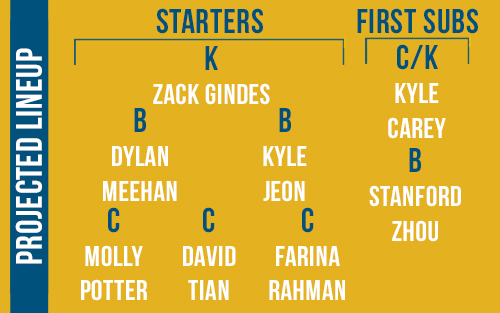 NYU’s strongest asset isn’t Jeon’s beating or Zack Gindes’ rifling long shots—it’s their strategy. Jeon treats every game like it is a chess match. On defense, he is not afraid to change personnel and schemes depending on what other teams bring to the table. At this year’s World Cup, NYU will use two male beaters at times and one female beater at others. They will play an extremely tight zone against some teams and a looser, man defense when they deem it fit.
NYU’s strongest asset isn’t Jeon’s beating or Zack Gindes’ rifling long shots—it’s their strategy. Jeon treats every game like it is a chess match. On defense, he is not afraid to change personnel and schemes depending on what other teams bring to the table. At this year’s World Cup, NYU will use two male beaters at times and one female beater at others. They will play an extremely tight zone against some teams and a looser, man defense when they deem it fit.
The only real way to be prepared for the Nundu’s permeable defense is to be prepared for everything and be able to adjust to their adjustments at the “b” of “brooms up!” This only stresses the importance of experience and discipline in an offense that faces NYU.
While it’s yet to be seen how NYU responds to high levels of physicality that the Southwest will bring to the table, the Nundu haven’t had trouble to this point in the season out-scheming teams with superior athleticism. It shouldn’t be a surprise if they do the same at World Cup.
 By Max Miceli
By Max Miceli
NYU is not the most athletic team; from top to bottom, the team isn’t too impressive or imposing athletically. Jeon provides a good bit of speed that will need to be matched, and Gindes can give the team some size mismatches. Aside from them, the team doesn’t look the part. This manifests itself most in its females, both beaters and chasers.
When NYU has been outmatched from a strategic standpoint in the second half of the fall, it’s been because teams have been able to exploit their female players. When NYU used a dual-male beating lineup against Tufts University in the Northeast Regional Championship final, Tufts looked to find chasers open because of mismatches against smaller female chasers around the hoops. When NYU has used a one-female-one-male beating lineup, teams like University of North Carolina-Chapel Hill have found some success on offense from targeting the Nundu’s female beater with a bludger and driving in on that side.
If NYU is going to beat top teams at World Cup, the team will have to see improvements from its females across the board. They don’t have to be Erin Mallory. They don’t have to be the next Audrey Wright. They just need to be good enough to keep the team in range. Jeon’s strategizing and Austin Sweeney’s seeking will do the rest.
 By Anonymous
By Anonymous
RIT, despite a disappointing performance at the Northeast Regional Championship where they finished 4-3 on the weekend, has steadily improved over the past two years. Entering World Cup 8, I would consider them a bracket play wild card. The team lives and dies through their athletic, starting keeper Shane Hurlburt, who functioned as both their top scorer and seeker this past fall. When Hurlburt is not using his speed to cause mismatches on the field, RIT can turn to his physically imposing and talented backup Aaron Pinzer to run over smaller or less-experienced opponents.
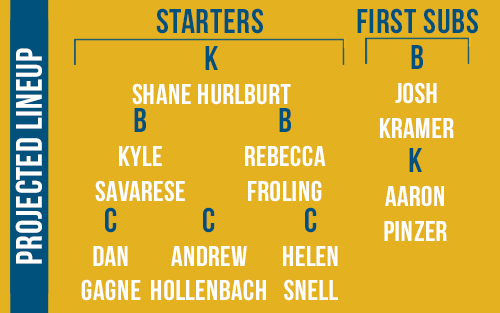 RIT will look to benefit from the full return of its talented beater tandem of Kyle Savarese and Josh Kramer, who came out of retirement to stabilize RIT’s beating corps at their regional. While both beaters utilize their speed and excellent decision making well, Savarese provides some of the best offensive beating in the Northeast, while Kramer excels in one-and-a-half situations and as a seeker beater.
RIT will look to benefit from the full return of its talented beater tandem of Kyle Savarese and Josh Kramer, who came out of retirement to stabilize RIT’s beating corps at their regional. While both beaters utilize their speed and excellent decision making well, Savarese provides some of the best offensive beating in the Northeast, while Kramer excels in one-and-a-half situations and as a seeker beater.
RIT depends heavily on their aforementioned male stars but that shouldn’t diminish the importance of chaser Helen Snell. Small and aggressive, this wing chaser provides some of the best shutdown defense on the team. Look to Snell and fellow chaser Alyssa Giarosso to prove RIT’s female depth is a non-issue.
Any team looking to contend with RIT has to contend with this simple fact: they will hit you, and they will you hit hard. They prefer to use their aggressive defensive style to force turnovers, where they then utilize the speed of quick players like Hurlburt and Daniel Gagne for a solid transition offense. Look for RIT to improve on its 14-6 fall record and enter World Cup VIII ready to continue its streak of World Cup success.
By Devin Sandon
The biggest factor in RIT’s success or failure in the spring semester will be their ability to improve coordination between their beaters and chasers. In the fall, with Savarese on co-op, Ryan Dennehy quitting and Kramer coming out of retirement just for the Northeast Regional Championship, RIT’s beaters displayed some rust mechanically. But what proved far more problematic was that the beaters were frequently out of sync with each other and the chasers, resulting in suboptimal positioning and unsupported aggression/overly conservative play in equal measures. The net effect was that RIT’s beaters weren’t able to establish either consistent offensive pressure or maintain a defensive position effectively. They allowed far too many opportunities for opponents to fast break. However, with Savarese back in Rochester and Kramer presumably practicing regularly for the semester, RIT has a wonderful opportunity to correct its communication and coordination issues. The degree to which they manage to do this will have a huge impact on their World Cup.
Another important piece for RIT is the return and reincorporation of Andrew Hollenbach. While Hollenbach has never really been in the limelight, he is a fantastically versatile player who could easily be slotted into either their chaser or beater rotation. However, with RIT’s passing offense suffering toward the end of the fall, I think he could easily serve as a catalyst for its return.
Graphics by Amanda Dallas. Feature photo illustration by Mike Iadevaia.



